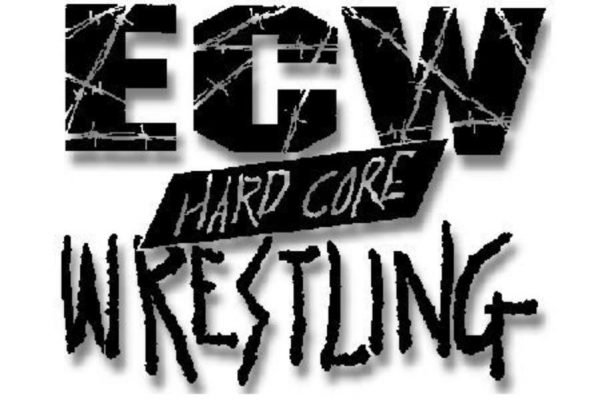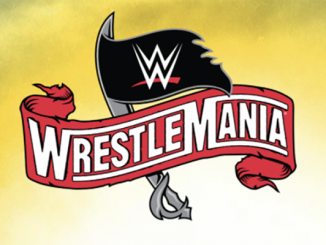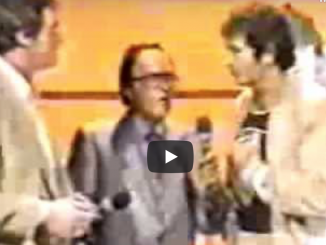
SPOTLIGHTED PODCAST ALERT (YOUR ARTICLE BEGINS A FEW INCHES DOWN)...
This month marks the 25th Anniversary of Bruce Mitchell becoming a Pro Wrestling Torch Newsletter columnist. No single person has influenced the editorial tone and direction of the Torch brand over the years than Bruce, who brought a hard-hitting, supremely well-informed, speak-truth-to-power approach to his writing. He went after sacred cows out of the gate, such as the beloved among “smart fans” (today’s “Internet fans” or “IWC,” I suppose) Eddie Gilbert and Jim Cornette. He also went hard after people in positions of authority and power who were abusing or misusing that power, or just not delivering a worthy product. He has also applauded and paid tribute to the greatest moments and movements in pro wrestling over the last 25 years, with a style of writing that has yet to be matched anywhere, I contend (despite Bill Simmons’s arrogant and uninformed contention last year that no one wrote at a high level about pro wrestling until his “Masked Man” columnist came along).
To celebrate and highlight Bruce’s stellar 25 years of influential and eloquent truth-telling about this fascinating industry, we’ll be featuring a single column from each of the last 25 years each of the first 25 days this month. His long-form columns were a pioneer approach to pro wrestling journalism, and the next 25 years you’ll experience a slice of what it is that has earned Bruce Mitchell widespread recognition within the industry over the years as being “Pro Wrestling’s Most Respected Columnist.” We began on Oct. 1st with his very first column, from Pro Wrestling Torch Newsletter #89 (cover dated Oct. 5, 1990).
Today we feature his column from the July 5, 2000 edition of the Pro Wrestling Torch Newsletter titled “Death of Hardcore” in which he proposes the era of “hardcore wrestling” was over
NOTE: VIP members can access hundreds of Mitchell columns instantly in the BRUCE MITCHELL LIBRARY here, part of the massive unmatched online archives of insider wrestling coverage from over the past 28 years.
===
By Bruce Mitchell, Torch columnist”Death of Hardcore”
Originally published: July 5, 2000
Pro Wrestling Torch Weekly newsletter #610
hardcore (hard’kor’) adj. 1. Immensely loyal; die-hard. 2. Stubbornly resistant to improvement or change. 3. Extremely graphic or explicit.
-American Heritage Dictionary
As ECW employees and fans sweat out the promotion’s leap into the breach, either to move up into a much more competitive position, or down into inevitable dissolution, the mantra the company was founded on has become meaningless.
ECW is hanging by a thread about to be cut by the twin scissors of its supposed enemy, TNN, and its supposed friend, the WWF. The two have damaged ECW’s already weak chances for another cable TV deal by strangely delaying the ECW show’s cancellation until September 22, when the Fall TV schedule starts everywhere at the beginning of that month, making it even more difficult for its low rated show to find another national outlet.
TNN sticks it back to a company that spent months foolishly taunting them over their own airwaves, and the WWF makes sure USA Network can’t seamlessly slide another wrestling show into its traditional Monday night slot. The WWF has been killing ECW softly ever since they did them the Tazz “favor.”
Add that to a stale, lifeless in?ring product, production values worthy of Southeastern Championship Wrestling circa 1979, and a business plan the equivalent of using one credit card to pay another, then using that one to pay the next, and it’s clear ECW is in real trouble. The Hardcore Revolution may well be over.
The TNN show is just awful, and as formulaic as a Scooby Doo mystery. Every show for months now has gone exactly the same way: Joey Styles introduces the show, then Joel Gertner tells a filthy limerick (and if you’ve heard one you’ve heard them all). Then Cyrus, the only TNN executive with hair to his butt, taunts the two announcers, who do their best to act like Big Bad Tough Guys. They’ve just about had enough and are ready to punch Cyrus (who clearly could kick both of their assses without much problem) when, darn it, at the last moment the Network saves Cyrus.
Then there’s a match with ECW’s interchangeable set of indy quality workers (hopefully it’s not a garbage match – those really suck) so that Gertner and Styles can step on each other’s scripted “jokes” about TNN and farm animals. The only creativity left in the promotion is reserved for seeing how many anal references they can jam into one early evening hour and how many ways they can blame TNN for their failure.
There’s usually a skit with Mikey Whipwreck and the Sinister Minister. The Minister resembles nothing more than Jon Lovitz in that old “Saturday Night Live” bit where he wore a red polyester devil’s suit and went to small claims court to collect on souls.
In the middle of the show there’s usually a match involving some combination of Little Guido, Steve Corino, and Tajiri. Good action, if you can see any of it; ECW is so strapped for cash that they can’t properly light their television show. After ten or eleven minutes of commercials, the main event quickly follows where either Tommy Dreamer, Sandman, or Rob Van Dam gets the better of one of the Network also?rans like Jerry Lynn or the worthless Scotty Anton, then the rest of the Network run in to stomp him. Then either Dreamer or Sandman or Van Dam run in for the save.
Let’s hope it’s not Sandman, since his interminable walk?in loses a little the second dozen time you see it. Everybody runs at this ECW hero to feed him until Rhino puts the guy through a table.
Cyrus then yells, “Don’t mess with the Network!” for the not so big finish. One last attempt to put the heat on TNN, because the big, bad hardcore tough guys can’t face their own failure.
Repeat ad nauseum.
The ECW Hardcore Revolution is ending not with a bang, but with a whine.
In some ways it’s too bad because it really was a revolution. The mantra of “Hardcore” made ECW?and ended up remaking the entire business, changing its marketing scheme from the High Concept gimmick designed to appeal to children of all ages to the Radical gimmick designed to appeal to adolescent males of all ages.
Now, though, the chair swingin’, gangsta rappin’, hard rockin’, dope smokin’, crowd brawlin’, emm effin’ archetype is dying a slow, certain death, the victim of overexposure, corporate co?option, and an exhaustion of ideas.
The real future of ECW rests with its creative reinvention as much as it does with a new cable TV deal.
The good news is, Paul Heyman has done it before. If Heyman hadn’t had the vision to change what promoter Joel Goodhart’s Tri?States Wrestling Alliance, and, later, Tod Gordon and the late Eddie Gilbert’s Eastern Championship Wrestling had started?wrestling promotions for fans who were into everything that wasn’t Hulkamania?who knows whether Austin would have turned Stone Cold, and whether the business would have entered its boom period.
Goodhart’s promotion had quickly gone broke because, like many independent promoters, he had a hard time with the basic business concept of revenues exceeding expenses. Before the TWA folded, though, it had put on some high quality bloody brawls between Gilbert and Cactus Jack that garnered a lot of excitement from what would become ECW’s, and later, mainstream wrestling’s nascent fan base.
Paul Heyman didn’t invent Hardcore wrestling. He recognized the thirst in male fans for harder edged action and he saw a way to marry it with the new speed metal?rap scene and the exclusive Gotham nightclub scene he had grown up around.
The word “Hardcore” was not originally used in the genre to describe wrestlers, but a certain type of fan. Before the Internet, serious fans used newsletters to follow the inner workings of a business that much more jealously protected the supposed big secret. These fans first adopted a term that wrestlers had been using for decades to describe those “in the know” to differentiate themselves from the “marks” who were conned by the illusion.
The term was “Smarts.”
The reason that term didn’t last was twofold. First, many Smart fans weren’t – at least in the normal sense of the word. It seems silly now, after the entire industry has come clean about the entertainment aspects (giving it the credibility to lie about much more important issues), but there were fans who got off on doing things like yelling wrestlers’ real names at the matches. It must have been shocking for the other fans to find out that wrestlers such as Brutus Beefcake weren’t born with those names.
The other reason was, even for wrestling, the term was arrogant and obnoxious.
So somehow the word Hardcore was borrowed from the worlds of music and pornography to describe the type of fan who understood the action in the ring was an illusion, who loved Bruiser Brody, the Midnight Express, Terry Funk, Mid?South Wrestling, and Ric Flair, who hated Dusty Rhodes, Ultimate Warrior, WWF ice cream bars, and who suspected, or even knew, often the best action took place in Japan. Hardcore wrestling did one thing better than anything anywhere else. It kicked ass.
So, what difference does it make what the word “Hardcore” meant a decade ago, which in the rapidly changing wrestling world is the equivalent of several generations past?
Simple. The thing that robbed ECW of its energy and uniqueness was the subversion of the word “Hardcore” itself. Hardcore no longer kicks ass.
When Paul Heyman changed the “E” in “ECW” from “Eastern” to “Extreme,” when he changed the Sandman to a guy in South Philly with a wet suit and a surfboard (I’m not making this up) to a boozehound who smoked like he was on fire, who pimped out his wife and beat up her johns (“Tommy Cairo, pay your bills”), when he changed Shane Douglas from a bland face to a championship Franchise, and turned the over?aged Cheetah Kid and a fat indy guy into the street thugs Public Enemy, when he gave Sabu a national platform to bust tables (you know ol’ Terry Brunk and his Uncle Sheik must be pissed when they see the Dudleys do a much easier version of his act in the big time), when he let Tommy Dreamer take beating after beating for his sins, Heyman created a wrestling promotion unlike any other of its time.
ECW was the anti-promotion, dedicated to showing up the Big Two promotions of the WWF and particularly WCW. They were the hungry underdog who loved to stick it to the bloated clowns who were strangling the industry. With their quick cuts and great music, their television show may have been cheaper, but it was faster and cooler than the then staid Big Two shows.
In contrast to the pathetic complaining about TNN of today, then it was the joyful razzing of an up-and-comer who knows they are beating their elders at their own game. For a while there, ECW was doing exactly that?at least in the ring.
In the early ’90s the WWF was at a financial and creative ebb, the life sucked out of it by the twin demons of the feds’ steroid trial and a stale marketing plan. They couldn’t continue to promote the huge swollen stiffs who tried to make up with freakish charisma what they didn’t have in action.
The Hulk Hogan kiddie franchise, which Vince McMahon had ridden for years, was even then at the point of diminishing returns. Hogan had been a primary target of the federal investigation, and had to finally admit what he lied about all of those years when he was telling children to say their prayers and take their vitamins so they could grow up to be like him. He was either “retired” or was “taking a leave of absence,” depending on your level of gullibility.
In an incredible coincidence, Hogan hadn’t passed that famous torch to a predecessor, and the WWF was uneasily pushing the likes of Lex Luger, Tatanka, Yokozuna, and Diesel. Finally in desperation, because it was against everything the big man promotion had ever stood for, they pushed Bret Hart and Shawn Michaels because they were the best workers in the company.
The WWF was at a loss, clinging to the last decade’s formula, and ripe for the hardcore backlash. WCW was in much worse shape.
Like now, WCW was run by incompetents who turned everything they touched to red ink. Unlike today, back then there wasn’t even the entertaining distraction of watching highly paid con men cut each others’ political throats to keep their spots. What little decent wrestling there was came from Ric Flair, Sting, Cactus Jack, and Vader ? with flashes from the Hollywood Blondes team of Steve Austin and the late Brian Pillman.
Hardcore fans increasingly hated both promotions for their constant efforts to dull the violent edges that gave the sport its vulgar life. Whether it was the wrestling garbageman Duke “The Dumpster” Droese or the geeky blonde Cole twins, both promotions were ripe for ridicule.
It was, as they all are, a unique moment in wrestling history. An increasing number of fans were thirsty for a more adult (well, late teen) style. The Big Two still wanted to use the juiced?up oafs that had been their calling cards. Paul Heyman saw a window where his promotion could create a new way to satisfy a growing audience of male fans who were angry at the Big Two, angry at their parents, angry at their bosses, angry at the women who taunted them with their looks, angry at their mommies, angry at those hard to pop tops on their beers?
ECW felt their pain.
Meanwhile, a new generation of wrestlers was learning how to work by doing what hardcore fans of the time did, studying the tapes of Japanese and Mexican wrestling promotions. WCW and the WWF had no place at the time for these wrestlers’ much more advanced, athletic style, so they had to go overseas or across the border to get work. It was hard for them, but the crucible of working these styles forged many of them into potential stars.
One of the strengths of ECW, then and now, has been Paul Heyman’s ability to find good wrestlers whom the other two companies, for whatever reason, have missed. ECW was strengthened through the years by what today have become the cream of American workers, guys who couldn’t get a look until ECW gave them a forum. They included Chris Jericho, Chris Benoit, Eddy Guerrero, Psicosis, The Dudleys, Rey Mysterio Jr., Cactus Jack, Juventud Guererra, Dean Malenko, Tazz, Perry Saturn, Raven, and a host of others. The key guy, though, was there for only a short time, the equivalent of a cup of coffee.
Steve Austin began his own reinvention in the ECW Arena, and his reinvention taught Vince McMahon how to reinvent his own promotion. The more “Stone Cold” Steve Austin got over, and the more the WWF got “Attitude,” the less unique ECW became. The WWF could afford the best of the wild?men wrestlers, and for a while there, WCW took the best of the pure workers.
That, of course, is pretty obvious. What wasn’t so obvious is how the WWF, and their imitators at WCW, subverted the meaning of “Hardcore” until it became a silly joke, perfect for the opening match or for TV comic relief, but wrong for ticket selling main events.
The WWF Hardcore Title, by design, is the silliest title in wrestling. Mick Foley may have been the first Hardcore Champion, mainly because a look?alike fan gave him a homemade version of a belt with that name at an autograph session at John Hitchcock’s “Parts Unknown” comic book store (I know, I was there) and Foley showed it around backstage at the pay?per?view show later that weekend.
The title was then introduced on TV and Mick Foley gave it instant credibility, but it wasn’t long before the main eventers were kept far away from the Hardcore Title. ECW had already taught everyone that any idiot can whack someone backstage with a chair, or a light pole, or a garbage can, or a wall. The WWF and WCW killed hours of their programs with this garbage.
Anyone, from the popcorn vendor to the referee to a ‘ho to the old stooges can – and often have – won the Hardcore belt. The perennial champion is Crash Holly, who is a good wrestler but the antithesis of what used to be the typical Hardcore wrestler. Crash Holly is a cartoon character who talks in a high voice and gets bounced around everywhere. The WWF changed Hardcore Wrestling from Bruiser Brody to Elroy Jetson.
It’s no accident that Tazz, the long-running ECW World Heavyweight Champion who almost never lost, did a series of rapid-fire jobs in a Hardcore Battle royal to mid-card wrestlers shortly after entering the WWF. It’s the WWF’s way of making it clear that being King of Hardcore in ECW puts you in the mix with Crash Holly, not Triple H.
Wrestling fans have gotten the underlying message. They can get everything ECW used to stand for, pushed to the ‘nth degree by the best production values in the history of the business. Today wrestling fans want Rock, not Revolution.
SIDEBAR: WHAT NOW FOR ECW?
So what can Paul Heyman and ECW do now to survive and thrive, which, unless you’re WCW – the welfare promotion – is the same thing?
-ECW can’t make it without national cable television (syndication is impossibly expensive). Bringing money marks in to keep the promotion afloat is just a stop-gap measure that prolongs the inevitable. Paul Heyman is great at rationalizations, and he’ll have plenty of them if this happens – and it is the most likely option. One of the keys to ECW’s long-term survival has been the carrot of growth (pay-per-view, national television) kept in front of wrestlers who might otherwise settle for being opening match or mid-card wrestlers in the Big Two. That will be over, as will be the prospects of keeping the promotion’s top wrestler, Rob Van Dam, unless they get a cable TV deal and major financial support.
-ECW can’t make it working with (for) one of the Big Two. They’ve already seen what happens when the WWF “helps” them. WCW can’t even help themselves. The only real reason to work with one of the Big Two is if Heyman wanted to get a job for himself (and Dreamer) before ECW is no more.
-The most important thing ECW needs is the hardest thing to get: major financing from a cable TV entity. ECW needs to be financed to the extent a similar first-run television show on the same network at the same time for 52 weeks a year would be, because modern wrestling is first of all television programming. The days of Paul Heyman running the promotion out of the basement of his parents’ home makes for a romantic story, but that practice has to end if ECW has any hope of competing.
ECW has to have modern production values to compete, enough to retake their reputation as cutting-edge television. They have to have enough financing to compete for young talent, and to keep them.
-Paul Heyman is going to have to give up control on the financial end while retaining creative control of the promotion, whether he likes it or not. ECW can no longer do business in the gray areas if they want the benefits of corporate synergy. He is also, at the same time, going to have to keep the product out of hands of the type of know-nothing suits who would push the likes of Randy Savage on the company.
-The next thing they have to do is close up shop for six months. Make the July pay-per-view the last one for the foreseeable future and a sentimental celebration of the company’s colorful history. End it by giving Tommy Dreamer what he deserves for his years of sacrifice: the ECW Title.
ECW workers and fans need a sabbatical. Most of ECW’s wrestlers can live off of their ECW/TNN name value on the indy scene or in Japan for months. It’s worth the risk of losing a few names.
It’s time to face reality. Paul Heyman and ECW are burned out shells of what they once were. A wrestling rule of thumb says most successful bookers run out of money-making ideas at about the fourth year, no matter how creative they may be (Dusty Rhodes, Bill Watts, Jim Cornette, Pat Patterson, Vince Russo). One look at Paul Heyman today tells the story. ECW needs time to refresh and reconsider its mission. And the wrestlers certainly could use the time.
It does no good for this tired bunch to get another time slot immediately. They’ll fail because ECW as it exists now, paychecks up to date or not, can’t compete in the new world the WWF and Viacom have created.
-Heyman must convince USA Network, if they are interested at all, not to just throw ECW into the schedule in September when they’re not ready. He must convince them that ECW can offer the kind of long-term relationship and potential profits they had with the WWF, if only given the time and resources to prepare properly.
-Take the time to build up fan anticipation of a new ECW. Keep the strengths (Van Dam, Rhino, Cyrus, Minister, Tajiri, Super Crazy), freshen up the announcing, find new talent that fits, dump the burnouts and not-readys, and get the energy back that made ECW an underdog that wrestling fans could root for. ECW can’t be as big as the WWF, but it can be hungrier.
-To paraphrase Ronald Reagan on his defense budget: Spend some money on wardrobe. ECW wrestlers look too much like their fans. They should look like stars if that’s the way they expect to be perceived.
-Work with Rob Van Dam, Rhino, Justin Credible, and whoever else on the things that separate the stars from the good wrestlers. Entrances and catch-phrases are a must (Hint: 4:20 references are hackneyed). They need the timing of real stars to go with their athleticism. The Rock and Triple H finally made it when they learned how to do nothing better than most wrestlers do something – and then how to turn it on when the time is right. Think DeNiro.
-Figure out the new face of ECW and the long-term storylines. Steal back some of the things that made ECW Extreme, but do more things that make it new and fresh. Look to the movies, to the club scene, to the music the way ECW did when they broke out.
-Paul Heyman needs personnel support so he can concentrate on the creative end, stop playing lawyer, and get a night’s sleep every once in a while. As the WWF and WCW have both shown, it takes the creative vision and power of the right person on top to succeed.
ECW reinvented the wrestling business. Now, Paul Heyman must figure out how to reinvent ECW so it is as fresh and new in today’s wrestling scene as it was in the early ’90s. Many of the tricks that worked back then have played out – the no-sell stunts and bad brawling, the unathletic cat fights, and the gratuitous swearing. The best part of Hardcore Wrestling – the fighter with the heart to keep coming, will need a twist for the new century. Everything in ECW should be up for grabs – the look, the music, the wrestlers on the roster, the announcing styles, the production values. ECW was great because it was new and novel. Whether it means recharging and renewing the current formula, or shutting down and starting from scratch with a completely new approach, it’s time ECW is made new and novel again.
===
CHECK OUT PREVIOUS YEARS’ SELECTIONS OF BRUCE MITCHELL COLUMNS OVER THE LAST 25 YEARS: CLICK HERE




Leave a Reply
You must be logged in to post a comment.